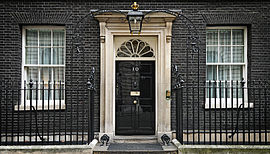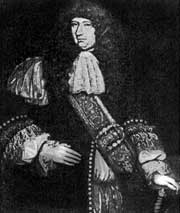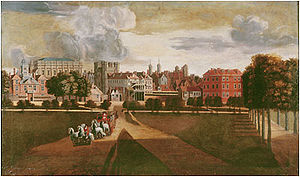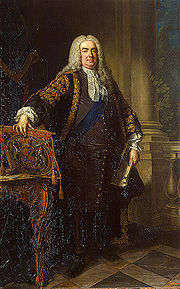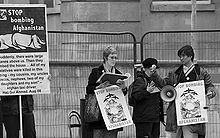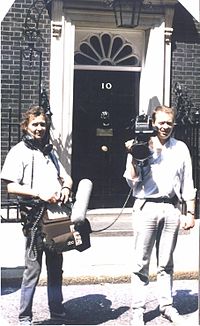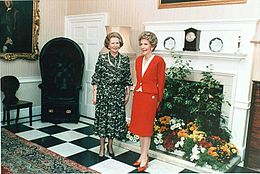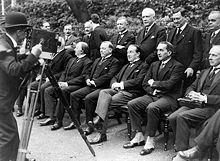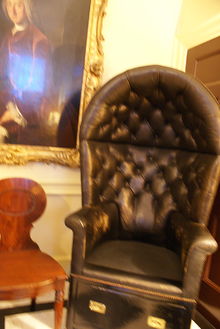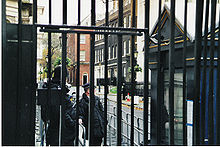
10 Downing Street
Background to the schools Wikipedia
SOS Children have produced a selection of wikipedia articles for schools since 2005. Visit the SOS Children website at http://www.soschildren.org/
| Number 10 Downing Street | |
|---|---|
 |
|
| General information | |
| Town or city | City of Westminster, London |
| Country | United Kingdom |
| Coordinates | 51.503396°N 0.127640°W Coordinates: 51.503396°N 0.127640°W |
| Construction started | 1682 - 1684 |
| Design and construction | |
| Client |
First Lord of the Treasury – Prime Minister of theUnited Kingdom |
| Website | |
| http://www.number10.gov.uk/ | |
10 Downing Street, colloquially known in the United Kingdom as "Number 10", is the headquarters of Her Majesty's Government and the official residence and office of the First Lord of the Treasury, an office now invariably held by the Prime Minister.
Situated in Downing Street in the City of Westminster, London, Number 10 is one of the most famous addresses in the world. Over three hundred years old, the building contains about one hundred rooms. There is a private residence on the third floor and a kitchen in the basement. The other floors contain offices and numerous conference, reception, sitting and dining rooms where the Prime Minister works, and where government ministers, national leaders and foreign dignitaries are met and entertained. There is an interior courtyard and, in the back, a terrace overlooking a garden of 0.5 acres (2,000 m2). Adjacent to St. James's Park, Number 10 is near to Buckingham Palace, the official London residence of the British monarch, and the Palace of Westminster, the meeting place of both houses of parliament.
Originally three houses, Number 10 was offered to Sir Robert Walpole by George II in 1732. Walpole accepted on the condition that they be a gift to the office of First Lord of the Treasury rather than to him personally. Walpole commissioned William Kent to join the three houses together. It is this larger house that is known today as "Number 10 Downing Street".
The arrangement was not an immediate success. Despite its size and convenient location near to Parliament, few early Prime Ministers lived there. Costly to maintain, neglected, and run-down, Number 10 was close to being razed several times. Nevertheless, the property survived and became linked with many statesmen and events in British history. In 1985 Prime Minister Margaret Thatcher said Number 10 had become "one of the most precious jewels in the national heritage."
History of the building
The original Number 10
Number 10 Downing Street was originally three houses: a mansion overlooking St. James's Park (called "the House at the Back"), a townhouse behind it and a cottage. The townhouse, from which the modern building gets its name, was one of several built by Sir George Downing between 1682 and 1684.
Downing, a notorious spy for Oliver Cromwell and later Charles II, invested in properties and acquired considerable wealth. In 1654, he purchased the lease on land south of Saint James's Park, adjacent to the House at the Back, and within walking distance of Parliament. Downing planned to build a row of townhouses designed "for persons of good quality to inhabit in ..." The street on which he built these homes now bears his name, and the largest became part of today's Number 10 Downing Street.
Straightforward as this investment seemed, it proved otherwise. There was another claim to the land: the Hampden family had a lease that they refused to relinquish. Downing fought this claim, but failed and consequently had to wait thirty years before he could build his houses. When the Hampden lease expired, Downing received permission to build further west to take advantage of recent real estate developments. The new warrant issued in 1682 reads: "Sir George Downing ... [is authorised] to build new and more houses ... subject to the proviso that it be not built any nearer than 14 feet of the wall of the said Park at the West end thereof." Between 1682 and 1684, Downing built a cul-de-sac of two-storey townhomes complete with coach-houses, stables and views of St. James's Park. Over the years, the addresses changed several times. In 1787 Number 5 became "Number 10".
Downing employed Sir Christopher Wren to design his houses. Although large, they were put up quickly and cheaply on soft soil with shallow foundations. The fronts, for example, were facades with lines painted on the surface imitating brick mortar. Prime Minister Winston Churchill wrote that Number 10 was "shaky and lightly built by the profiteering contractor whose name they bear."
The upper end of the Downing Street cul-de-sac closed off access to St. James's Park, making the street quiet and private. An advertisement in 1720 described it as: "... a pretty open Place, especially at the upper end, where are four or five very large and well-built Houses, fit for Persons of Honour and Quality; each House having a pleasant Prospect into St. James's Park, with a Tarras Walk." They had several distinguished residents. The Countess of Yarmouth lived at Number 10 between 1688 and 1689, Lord Lansdowne from 1692 to 1696 and the Earl of Grantham from 1699 to 1703.
Downing probably never lived in his townhouses. In 1675 he retired to Cambridge, where he died in 1684, a few months after building was completed. Downing's portrait now hangs in the entrance foyer of the modern Number 10 Downing Street.
History of the "House at the Back" before 1733
The "House at the Back", the largest of the three houses that were combined to make up Number 10, was a mansion constructed around 1530 next to Whitehall Palace. Rebuilt, expanded, and renovated many times since, it was originally one of several buildings that made up the "Cockpit Lodgings", so-called because they were attached to an octagonal structure used as a cock-fighting ring. Early in the 17th century, the Cockpit was converted to a concert hall and theatre; after the Glorious Revolution, some of the first Cabinet meetings were secretly held there.
For many years, the "house at the back" was the home of the Keeper of Whitehall Palace, Thomas Knevett (or Knyvet), famous for capturing Guy Fawkes in 1605 and foiling his plot to assassinate James VI and I. The previous year, Knevett moved into a house next door, approximately where Number 10 is today.
From this time, members of the royal family and the government usually lived in the "House at the Back". Princess Elizabeth lived there from 1604 until 1613 when she married Frederick V, Elector Palatine and moved to Heidelberg. She was the grandmother of George, the Elector of Hanover, who became King of Great Britain in 1714, and the great-grandmother of George II, who presented the house to Walpole in 1732.
George Monck, 1st Duke of Albemarle, the general responsible for the restoration of the monarchy, lived there from 1660 until his death in 1671. As head of the Great Treasury Commission of 1667–1672, Albemarle transformed accounting methods and allowed the Crown greater control over expenses. His Secretary, Sir George Downing, who later built Downing Street, is thought to have created these changes. Albemarle is the first Treasury minister to live in what would eventually become the home of the First Lord of the Treasury and Prime Minister.
In 1671, George Villiers, 2nd Duke of Buckingham, took possession when he joined the Cabal Ministry. (The "B" in the acronym CABAL refers to Buckingham.) At considerable expense, Buckingham rebuilt the house. The result was a spacious mansion, lying parallel to Whitehall Palace with a view of St. James Park from its garden.
After Buckingham retired in 1676, Lady Charlotte Fitzroy, Charles II's daughter, moved in when she married Edward Lee, 1st Earl of Lichfield. The Crown authorised extensive rebuilding again that included adding a storey, giving it three main floors, an attic and basement. This structure can be seen today as the rear section of Number 10. (See Plan of the Premises Granted to the Earl and Countess of Lichfield in 1677) The likely reason that repair was required is that the house had settled in the swampy ground near the Thames, causing structural damage. Like Downing Street, it rested on a shallow foundation, a design error that would cause problems until 1960 when the modern Number 10 was rebuilt on deep pilings.
The Litchfield family followed James II into exile after the Glorious Revolution. In 1690, William III and Mary II gave the "House at the Back" to Hendrik van Nassau-Ouwerkerk, a Dutch general who had assisted in securing the Crown for the then-Prince of Orange. Nassau, who Anglicised his named to "Overkirk", lived there until his death in 1708.
The "House at the Back" reverted to the Crown when Lady Overkirk died in 1720. The Treasury issued an order "for repairing and fitting it up in the best and most substantial manner" at a cost of £2,522. The work included: "The Back passage into Downing street to be repaired and a new door; a New Necessary House to be made; To take down the Useless passage formerly made for the Maids of Honour to go into Downing Street, when the Queen lived at the Cockpit; To New Cast a great Lead Cistern & pipes and to lay the Water into the house & a new frame for ye Cistern." (See Buildings on the Site of the Cockpit and Number 10 Downing Street c1720)
Johann Caspar von Bothmer, Count Bothmer, envoy from Hanover and advisor to George I and II, took up residency in 1720. Although Bothmer complained about "the ruinous Condition of the Premises", he lived there until his death in 1732.
The First Lord's House: 1733–1735
When Count Bothmar died, ownership of the "House at the Back" reverted to the Crown. George II took this opportunity to offer it to Sir Robert Walpole, often called the first Prime Minister, as a gift for his services to the nation: stabilising its finances, keeping it at peace and securing the Hanoverian succession. Coincidentally, the King had obtained the leases on two Downing Street properties, including Number 10, and added these to his proposed gift.
Walpole did not accept the gift for himself. He proposed—and the King agreed—that the Crown give the properties to the Office of First Lord of the Treasury. Walpole would live there as the incumbent First Lord, but would vacate it for the next one.
To enlarge the new house, Walpole persuaded Mr Chicken, the tenant of a cottage next door, to move to another house in Downing Street. This small house and the mansion at the back were then incorporated into Number 10. Walpole commissioned William Kent to convert them into one building. Kent joined the larger houses by building a two-storey structure between them, consisting of one long room on the ground floor and several above. The remaining interior space was converted into a courtyard. He connected the Downing Street houses with a corridor.
Having united the structures, Kent gutted and rebuilt the interior. He then surmounted the third storey of the house at the back with a pediment. To allow Walpole quicker access to Parliament, Kent closed the north side entrance from St. James's Park, and made the door in Downing Street the main entrance.
The rebuilding took three years. On 23 September 1735, the London Daily Post announced that: "Yesterday, the Right Hon. Sir Robert Walpole, with his Lady and Family moved from their House in St James's Square, to his new House adjoining to the Treasury in St. James's Park." The cost of conversion is unknown. Originally estimated at £8,000, the final cost probably exceeded £20,000.
Walpole did not enter through the now-famous door; that would not be installed until forty years later. Kent's door was modest, belying the spacious elegance beyond. The First Lord's new, albeit temporary, home had sixty rooms, with hardwood and marble floors, crown moulding, elegant pillars and marble mantelpieces; those on the west side with beautiful views of St. James's Park. One of the largest rooms was a study measuring forty feet by twenty with enormous windows overlooking St. James's Park. "My Lord's Study" (as Kent labelled it in his drawings) would later become the Cabinet Room where Prime Ministers meet with the Cabinet ministers.
Shortly after moving in, Walpole ordered that a portion of the land outside his study be converted into a terrace and garden. Letters patent issued in April 1736 state that: "... a piece of garden ground situated in his Majesty's park of St. James's, & belonging & adjoining to the house now inhabited by the Right Honorable the Chancellor of His Majesty's Exchequer, hath been lately made & fitted up at the Charge ... of the Crown".
The same document confirmed that Number 10 Downing Street was: "meant to be annexed & united to the Office of his Majesty's Treasury & to be & to remain for the Use & Habitation of the first Commissioner of his Majesty's Treasury for the time being."
A "vast, awkward house": 1735–1902

Walpole lived in Number 10 until 1742. He had accepted it as a gift from the Crown for future First Lords of the Treasury. However, it would be 21 years before any chose to live there; the five who succeeded Walpole preferred their own homes. This was the pattern until the beginning of the 20th century. Of the 31 First Lords from 1735 to 1902, only 16 (including Walpole) lived in Number 10.
A few enjoyed living in Number 10. Lord North, who conducted the war against the American Revolution, lived there happily with his large family from 1767 to 1782. William Pitt the Younger, who made it his home for twenty years—longer than any First Lord before or since—from 1783 to 1801 and from 1804 to 1806, referred to it as "My vast, awkward house." While there, Pitt reduced the national debt, formed the Triple Alliance against France, and won passage of the Act of Union that created the United Kingdom of Great Britain and Ireland. Fredrick Robinson, Lord Goderich took a special liking to the house in the late 1820s; he spent state funds lavishly remodelling the interior.
Nevertheless, for 70 years following Pitt's death in 1806, Number 10 was rarely used as the First Lord's residence. From 1834 to 1877, it was either vacant or used only for offices and meetings.
One reason many First Lords chose not to live in Number 10 was that most were peers who owned homes superior in size and quality. To them, Number 10 was unimpressive. Their "possession" of the house, albeit temporary, was a perk they could use as a political reward. Most lent it to the Chancellor of the Exchequer, others to lesser officials, and still others to friends or relatives.
Another reason was that Number 10 was a hazardous place to live. Prone to sinking because it was built on soft soil and a shallow foundation, floors buckled, walls and chimneys cracked; it became unsafe and frequently required repairs. In 1766, for example, Charles Townshend, the Chancellor of the Exchequer, pointed out that the house was in a dilapidated condition. His architect's letter to the Treasury read: "... we have caused the House in Downing Street belonging to the Treasury to be surveyed, & find the Walls of the old part of the said House next the street to be much decayed, the Floors & Chimneys much sunk from the level ..." Townsend ordered extensive repairs, but they were still incomplete eight years later. A note from Lord North to the Office of Works, dated September 1774, asks that the work on the front of the house, "which was begun by a Warrant from the Treasury dated 9 August 1766", should be finished. (See Kent's Treasury and No. 10, Downing Street, circa 1754.)
Treasury officials complained that the building cost too much to maintain; some suggested that it be razed and a new house constructed on the site or elsewhere. In 1782, the Board of Works, reporting on "the dangerous state of the old part of the House", stated that "no time be lost in taking down said building ..." In 1783, the Duke of Portland moved out because it was once again in need of repair. A committee found that the money spent so far was insufficient. This time the Board of Works declared that "the Repairs, Alterations & Additions at the Chancellor of the Exchequer's House will amount to the sum of £5,580, exclusive of the sum for which they already have His Majesty's Warrant. And praying a Warrant for the said sum of £5,580—and also praying an Imprest of that sum to enable them to pay the Workmen." This proved to be a gross underestimate; the final bill was over £11,000. The Morning Herald fumed about the expense: "£500 pounds p.a. preceding the Great Repair, and £11,000 the Great Repair itself! So much has this extraordinary edifice cost the country – For one moiety [one half] of the sum a much better dwelling might have been purchased!" (See Plan of the Design for Number 10 c1781)
Downing Street declined at the turn of the 19th century surrounded with run-down buildings, dark alleys, crime and prostitution. Earlier, the government had taken over the other Downing Street houses: the Colonial Office occupied Number 14 in 1798: the Foreign Office was at Number 16 and the houses on either side; the West India Department was in Number 18 and the Tithe Commissioners, Number 20. They deteriorated from neglect, became unsafe, and one by one were torn down. By 1857, Downing Street's town houses were all gone except for Number 10, Number 11 (customarily the Chancellor of the Exchequer's residence) and Number 12 (used as offices for Government Whips). In 1879, a fire destroyed the upper floors of Number 12; it was renovated but only as a single-storey structure. (See Numbers 10, 11, and 12 Downing Street First Floor Plan and Ground Floor Plan)
Revival and recognition: 1902–1960
When Lord Salisbury retired in 1902, his nephew, Arthur James Balfour, became Prime Minister. It was an easy transition: he was already First Lord of the Treasury and Leader of the House of Commons, and he was already living in Number 10.
Salisbury was the last Prime Minister who did not make Number 10 his official home. From 1877 when Disraeli moved into Number 10 the house had been – with the exception of Salisbury – occupied continuously by the Prime Minister. Salisbury was exceptional amongst Prime Ministers in not also serving as First Lord of the Treasury for all of his three premierships bare briefly from 1886 to 1887 at the start of his second ministry. During this time he briefly occupied Number 10 but then moved out. He lived at his home on Arlington Street in St. James's and his estate at Hatfield House while Prime Minister in 1887–1892 and 1895–1902. Balfour revived the custom that Number 10 is the First Lord and Prime Minister's official residence. It has remained the custom since.
However, there have been numerous times when Prime Ministers have unofficially lived elsewhere. Winston Churchill for example had a great affection for Number 10, but he grudgingly slept in the bunkered Annex of Number 10 for his safety during World War II. He rarely slept in his underground bedroom in the Cabinet War Rooms. To reassure the people that his government was functioning normally, he insisted on being seen entering and leaving Number 10 occasionally.
Harold Wilson, during his second ministry from 1974 to 1976, lived in his home on Lord North Street because Lady Wilson wanted "a proper home". Recognising its symbolic importance, he maintained the public illusion of living in Number 10, working there, holding meetings, and entertaining guests in the State Dining Room.
For most of his Premiership, Tony Blair lived in the larger residence above Number 11 to accommodate his large family. In May 2010, it was reported that Prime Minister David Cameron would also take up actual residence above Number 11, and his Chancellor George Osborne above Number 10.
Despite these exceptions, Number 10 has been known as the Prime Minister's official home for over one hundred years. By the turn of the 20th century, photography and the penny press had linked Number 10 in the public mind with the Premiership. The introduction of films and television would strengthen this association. Pictures of Prime Ministers with distinguished guests at the door became commonplace. With or without the Prime Minister present, visitors had their picture taken. Suffragettes posed in front of the door when they petitioned Herbert Asquith for women's rights in 1913, a picture that became famous and was circulated around the world. In 1931, Mohandas Gandhi, wearing the traditional homespun dhoti, posed leaving Number 10 after meeting with Ramsay MacDonald to discuss India's independence. This picture, too, became famous especially in India. Illiterate peasants could see their leader had been received in the Prime Minister's home. Couse's elegant, understated door—stark black, framed in cream white with a bold white "10" clearly visible—was the perfect backdrop to record such events (see Section 2.1 below). Prime Ministers made historic announcements from the front step. Waving the Anglo-German Agreement of Friendship, Neville Chamberlain proclaimed "Peace With Honour" in 1938 from Number 10 after his meeting with Adolf Hitler in Munich. During World War II, Churchill was photographed many times emerging confidently from Number 10 holding up two fingers in the sign for "Victory". The symbol of British government, Number 10 became a gathering place for protestors. Emmeline Pankhurst and other suffragette leaders stormed Downing Street in 1908; anti-Vietnam War protestors marched there in the 1960s, as did anti-Iraq and Afghanistan War protestors in the 2000s. Number 10 became an obligatory stop in every tourist's sightseeing trip to London. Ordinary people, not only British but foreign tourists, posed smiling and laughing in front of its famous door.
Rebuilding Number 10: 1960–1990
By the middle of the 20th century, Number 10 was falling apart again. The deterioration had been obvious for some time. The number of people allowed in the upper floors was limited for fear the bearing walls would collapse. The staircase had sunk several inches; some steps were buckled and the balustrade was out of alignment. An investigation ordered by Prime Minister Harold Macmillan in 1958 concluded that there was widespread dry rot. The interior wood in the Cabinet Room's double columns was like sawdust. Baseboards, doors, sills and other woodwork were riddled and weakened with disease. After reconstruction had begun, miners dug down into the foundations and found that the huge wooden beams supporting the house had decayed.
There was some discussion of tearing down the building and constructing an entirely new residence. But the Prime Minister's home had become an icon of British architecture like Windsor Castle, Buckingham Palace and the Houses of Parliament. Instead, it was decided that Number 10 (and Numbers 11 and 12) would be rebuilt using as much of the original materials as possible.
The interior would be photographed, measured, disassembled, and restored. A new foundation with deep pilings would be laid and the original buildings reassembled on top of it, allowing for much needed expansion and modernisation. Any original materials that were beyond repair – such as the pair of double columns in the Cabinet Room – would be replicated in detail. This was a formidable undertaking: the three buildings contained over 200 rooms spread out over five floors. The architect Raymond Erith carried out the design for this painstaking work. The contractor that so carefully undertook it was John Mowlem & Co.
The Times reported that initially the cost for the project would be £400,000. After more careful studies were completed, it was concluded that the "total cost was likely to be £1,250,000" and would take two years to complete. In the end, the cost was close to £3,000,000 and took almost three years due in large part to 14 labour strikes. There were also delays when archaeological excavations uncovered important artefacts dating from Roman, Saxon and mediaeval times. Macmillan lived in Admiralty House during the reconstruction.
The new foundation was made of steel-reinforced concrete with pilings sunk 6 feet (1.8 m) to 18 feet (5.5 m). The "new" Number 10 consisted of about 60% new materials; the remaining 40% was either restored or replicas of originals.
Reconstructed exactly as in the old Number 10 included the following: the garden floor, the door and entrance foyer, the stairway, the hallway to the Cabinet Room, the Cabinet Room, the garden and terrace, the Small and Large State Rooms and the three reception rooms.
The staircase was rebuilt and simplified. Steel was hidden inside the columns in the Pillared Drawing Room to support the floor above. The upper floors were modernised and the 3rd floor extended over Numbers 11 and 12 to allow more living space. As many as 40 coats of paint were stripped from the elaborate cornices in the main rooms revealing details unseen for almost 200 years in some cases.
When builders examined the exterior façade, they discovered that the black colour visible even in photographs from the mid-19th century was misleading; the bricks were actually yellow. The black appearance was the product of two centuries of pollution. To preserve the 'traditional' look of recent times, the newly cleaned yellow bricks were painted black to resemble their well-known appearance.
Although the reconstruction was generally considered an architectural triumph, Erith was disappointed. He complained openly during and after the project that the government had altered his design to save money. "I am heart broken", he said, "by the result ... the whole project has been a frightful waste of money because it just has not been done properly. The Ministry of Works has insisted on economy after economy. I am bitterly disappointed with what has happened."
Erith's concerns proved justified. Within a few years, dry rot was discovered, especially in the main rooms due to inadequate water-proofing and a broken water pipe. Extensive reconstruction again had to be undertaken in the late 1960s to resolve these problems. Further extensive repairs and remodelling, commissioned by then-Prime Minister Margaret Thatcher, were completed in the 1980s under the direction of Erith's associate, Quinlan Terry.
Rooms and special features
The front door and entrance hall
Most of the modern exterior shape and features of Number 10 were created by Kent when he combined the house at the back with the Downing Street townhouses in 1735. Its outside appearance is basically the same today as it was when he completed his work. An exception is the now famous front door entrance.
Number 10's famous door is the product of the renovations Townsend ordered in 1766; it was probably not completed until 1772. Executed in the Georgian style by the architect Kenton Couse, it is unassuming and narrow, consisting of a single white stone step leading to a modest brick front. The small, six-panelled door, originally made of black oak, is surrounded by cream-coloured casing and adorned with a semicircular fanlight window. Painted in white, between the top and middle sets of panels, is the number "10". The zero of the number "10" is set at a slight angle as a nod to the original number which had a badly fixed zero. A black iron knocker in the shape of a lion's head is between the two middle panels; below the knocker is a brass letter box with the inscription "First Lord of the Treasury". A black ironwork fence with spiked newel posts runs along the front of the house and up each side of the step to the door. The fence rises above the step into a double-swirled archway, supporting an iron gas lamp surmounted by a crown. (See The Entrance Door c1930: As seen from the outside)
After the IRA mortar attack in 1991, the original black oak door was replaced by a blast-proof steel one. Regularly removed for refurbishment and replaced with a replica, it is so heavy that it takes eight men to lift it. The brass letterbox still bears the legend "First Lord of the Treasury". The original door was put on display in the Churchill Museum at the Cabinet War Rooms.
Beyond the door, Couse installed black and white marble tiles in the entrance hall that are still in use. A Chippendale guard's chair sits in one corner. Once used when policemen sat on watch outside in the street, it has an unusual "hood" designed to protect them from the wind and cold and a drawer underneath where hot coals were placed to provide warmth. Scratches on the right arm were caused by their pistols rubbing up against the leather.
Couse also added a bow front to the small cottage—formerly Mr. Chicken's house—incorporated into Number 10 in Walpole's time. (See The Entrance Door c1930: As seen from inside showing the black and white marble floor and the door providing access to Number 11)
The main staircase
When William Kent rebuilt the interior of Number 10 between 1732 and 1734, his craftsmen created a stone triple staircase with no visible supports in the main section. With a wrought iron balustrade embellished with a scroll design and mahogany handrail, it rises from the garden floor to the third floor. Kent's staircase is the first architectural feature visitors see as they enter Number 10. Black and white engravings and photographs of all the past Prime Ministers decorate the wall; they are rearranged slightly to make room for a new picture of the most recent former Prime Minister. There are two photographs of Winston Churchill. (See The Main Stairway c1930 General view showing portraits of the Prime Ministers and Detail of the Wrought Iron Balustrade ) (See also Simon Schama's Tour of Downing Street. Pt4: The Staircase) Often in films Hedsor House in Buckinghamshire has been used as a replica location due to its near identical main staircase.
The Cabinet Room
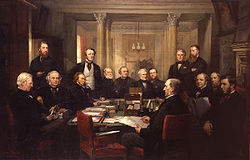
In Kent's design for the enlarged Number 10, the Cabinet Room was a simple rectangular space with enormous windows. As part of the renovations begun in 1783, the Cabinet Room was extended, giving the space its modern appearance. Probably not completed until 1796, this alteration was achieved by removing the east wall and rebuilding it several feet inside the adjoining secretaries' room. At the entrance, a screen of two pairs of Corinthian columns was erected (to carry the extra span of the ceiling) supporting a moulded entablature that wraps around the room. The resulting small space, framed by the pillars, serves as an anteroom to the larger area. Hendrick Danckerts' painting "The Palace of Whitehall (shown at the beginning of this article) usually hangs in the ante-room. Robert Taylor, the architect who executed this concept, was knighted on its completion.
Although Kent intended the First Lord to use this space as his study, it has rarely served that purpose; it has almost always been the Cabinet room. Painted off-white with large floor to ceiling windows along one of the long walls, the room is light and airy. Three brass chandeliers hang from the high ceiling. The Cabinet table, purchased during the Gladstone era, dominates the room. The modern boat-shaped top, introduced by Harold MacMillan in the late 1950s, is supported by huge original oak legs. The table is usually surrounded by twenty-three carved, solid mahogany chairs that also date from the Gladstone era. The Prime Minister's chair, the only one with arms, is situated midway along one side in front of the marble fireplace, facing the windows; when not in use, it is positioned at an angle for easy access. The only picture in the room is a copy of a portrait of Sir Robert Walpole by Jean-Baptiste van Loo hanging over the fireplace. Each Cabinet member is allocated a chair based on order of seniority. Blotters inscribed with their titles mark their places. Former US President Ronald Reagan was the first non-Cabinet member to sit at the table during a Cabinet meeting. The Cabinet Room also acts as a library; outgoing Prime Ministers traditionally donate to the collection.
The First Lord has no designated space in Number 10; each has chosen one of the adjoining rooms as his private office.
The Pillared State Drawing Room
Number 10 has three inter-linked State Drawing rooms: the Pillared Room, the Terracotta Room and the White Drawing Room.
The largest is the Pillared Room thought to have been created in 1796 by Taylor. Measuring 37 feet (11 m) long by 28 feet (8.5 m) wide, it takes its name from the twin Ionic pilasters with straight pediments at one end. Today, there is a portrait of Queen Elizabeth I over the fireplace; during the Thatcher Ministry (1979–1990), a portrait of William Pitt by Romney was hung there.
A Persian carpet covers almost the entire floor. A copy of a 16th century original now kept in the Victoria and Albert Museum, there is an inscription woven into it that reads: "I have no refuge in the world other than thy threshold. My head has no protection other than this porchway. The work of a slave of the holy place, Maqsud of Kashan in the year 926" (the Moslem year corresponding to 1520).
In the restoration conducted in the late 1980s, Quinlan Terry restored the fireplace. Executed in the Kentian style, the small Ionic pilasters in the overmantle are miniature duplicates of the large ones in the room. He also added ornate Baroque-style central ceiling mouldings and corner mouldings of the four national flowers of the United Kingdom: rose (England), thistle (Scotland), daffodil (Wales) and shamrock (Northern Ireland).
Sparsely furnished with a few chairs and sofas around the walls, the Pillared Room is usually used to receive guests before they go into the State Dining Room. However, it is sometimes used for other purposes that require a large open space. International agreements have been signed in this room. Tony Blair entertained the England Rugby Union team in the Pillared Room after they won the World Cup in 2003. And, John Logie Baird gave Ramsay MacDonald a demonstration of his invention, the television, in this room. (See The Pillared Drawing Room c1927 )
The Terracotta Room
The modern Terracotta Room was used as the dining room when Sir Robert Walpole was Prime Minister. The name of this room changes according to the colour it is painted. When Margaret Thatcher came to power it was the Blue Room and she had it re-decorated and renamed the Green Room. It is now painted terracotta. There are many famous works of art in this room, on loan from the Government Art Collection.
An ornate gilded ceiling was added during the 1989 renovation by Quinlan Terry to give the rooms a more stately look. Carved into in the plasterwork above the door leading to the Pillared Room is a tribute to Prime Minister Margaret Thatcher: a straw-carrying 'thatcher'.
The White Drawing Room
The White Drawing room was, until the 1940s, used by Prime Ministers and their wives for their private use. It was here that Edward Heath kept his grand piano. The room contains works by one of the most important English landscape painters of the nineteenth century, J M W Turner. Now it is often used as the backdrop for television interviews and is in regular use as a meeting room for Downing Street staff. The room links through to the Terracotta Room next door.
A notable feature of the room is the bronze statuette of Florence Nightingale (on loan from the Silver Trust). It is a reduced version of the Crimean Memorial in Waterloo Place in London, erected in 1915, commemorating the nurse's heroic work during the British victory in the Crimean War.
The State Dining Room
When Frederick Robinson (later Lord Goderich), became Chancellor of the Exchequer in 1823, he decided to leave a personal legacy to the nation. To this end, he employed Sir John Soane, the distinguished architect who had designed the Bank of England and many other famous buildings, to build a State Dining Room for Number 10. Begun in 1825 and completed in 1826 at a cost of £2,000, the result is a spacious room with oak panelling and reeded mouldings. Accessed through the first floor, its vaulted, arched ceiling rises up through the next so that it actually occupies two floors. Measuring 42 feet (13 m) by 26 feet (7.9 m), it is the largest room in Number 10. First used on 4 April 1826, Soane was the guest of honour.
The room is usually furnished with a table surrounded by 20 reproduction Adam style chairs originally made for the British Embassy in Rio de Janeiro. For larger gatherings, a horseshoe-shaped table is brought in that will accommodate up to 65 guests. On these occasions, the table is set with the Silver Trust Silver set given to Downing Street in the 1990s. (See the State Dining room with the Silver Trust Silver in use for a luncheon) Above the fireplace, overlooking the room, is a massive portrait by John Shackleton of George II, the king who originally gave the building to the First Lord of the Treasury in 1732. Celebrity chefs such as Nigella Lawson have cooked for Prime Ministers' guests using the small kitchen next door. Entering through the Small Dining Room, Blair used this room for his monthly press conferences. (See Simon Schama's Tour of Downing Street. Pt 3: The Dining Room See also The State Dining Room c1930: View toward the entrance and View from the entrance )
The Great Kitchen
The great kitchen located in the basement was another part of the renovations begun in 1783, probably also under the direction of Robert Taylor. Seldom seen by anyone other than staff, the space is two storeys high with a huge arched window and vaulted ceiling. Traditionally, it has always had a chopping block work table in the centre that is 14 feet (4.3 m) long, 3 feet (0.91 m) wide and 5 inches (130 mm) thick. (See The Kitchen c1930 View showing the table, window and ceiling )
The Small Dining or Breakfast Room
Above Taylor's vaulted kitchen, between the Pillared Room and the State Dining room, Soane created a Smaller Dining Room (sometimes called the Breakfast Room) that still exists. To build it, Soane removed the chimney from the kitchen to put a door in the room. He then moved the chimney to the east side, running a Y-shaped split flue inside the walls up either side of one of the windows above. The room therefore has a unique architectural feature: over the fireplace there is a window instead of the usual chimney breast.
With its flat unadorned ceiling, simple mouldings and deep window seats, the Small Dining Room is intimate and comfortable. Usually furnished with a mahogany table seating only eight, Prime Ministers have often used this room when dining with family or when entertaining special guests on more personal state occasions. (See the Small Dining or Breakfast Room c1927. The double doors behind the table lead to the State Dining Room. )
The Terrace and Garden
The terrace and garden were constructed in 1736 shortly after Walpole moved into Number 10. The terrace, extending across the back, provides a full view of St. James's Park. The garden is dominated by an open lawn of 0.5 acres (2,000 m2) that wraps around Numbers 10 and 11 in an L-shape. No longer "fitted with variety Walle fruit and diverse fruit trees" as it was in the 17th century, there is now a centrally located flower bed around a holly tree surrounded by seats. Tubs of flowers line the steps from the terrace; around the walls are rose beds with flowering and evergreen shrubs. (See North elevation of Number 10 with steps leading to the garden ) The terrace and garden have provided a casual setting for many gatherings of First Lords with foreign dignitaries, Cabinet ministers, guests, and staff. Prime Minister Tony Blair, for example, hosted a farewell reception in 2007 for his staff on the terrace. John Major announced his 1995 resignation as leader of the Conservative Party in the garden. Churchill called his secretaries the "garden girls" because their offices overlook the garden. It was also the location of the first press conference announcing the Coalition Government between David Cameron's Conservatives and Nick Clegg's Liberal Democrats.
Furnishings
Until the late 19th century, Prime Ministers were required to furnish Number 10 at their own expense. This arrangement began to change when Benjamin Disraeli took up residency in November 1877. The house had not been used as the Prime Minister's home for thirty years. Although the Treasury paid for the cost of repairs, as it had done in the past, Disraeli now insisted it should also bear the cost of furnishings at least in the public areas. He pointed out that this had been the practice at Number 11, the official residence of the Chancellor of the Exchequer, for twenty five years. The Treasury agreed and a practice similar to the one used for the tenant of Number 11 was developed for the tenant of Number 10. A memo dated 30 May 1878 defined as public places the entrance hall, staircase and first floor rooms (including the Cabinet room), and specified that these should be furnished at the state's expense. All other areas were defined as private, and the furnishings in them purchased by the prime minister. When a new prime minister moved in, an inventory would be taken of the furniture, together with an estimate of its value. To this list would be added the cost of additional furnishings requested by the new occupant and the cost of repairs made to furniture during his occupancy. On leaving, the outgoing Prime Minister would then pay for wear and tear, determined by subtracting the value of the furniture at that time from the initial cost.
This complex procedure was used until November 1897. Since then, the state has purchased and maintained all furnishings in Number 10, even in the private residency. Prime Ministers bring only their personal belongings.
Security at Number 10 after the 1991 bombing
For most of its history, Downing Street was accessible to the public. There was some security at Number 10 but it was minimal: a police officer standing guard. The front door has no keyhole on the outside. A second officer is on duty in the entrance hall to open it for the Prime Minister.
Gates were installed at both ends of the street during the premiership of Margaret Thatcher due to terrorist threats. On 7 February 1991, the Provisional IRA used a van they parked in Whitehall to launch a mortar shell at Number 10. It exploded in the back garden, while Prime Minister John Major was holding a Cabinet meeting. Major moved to Admiralty House while repairs were completed. Because of this attack, heavier security measures were imposed, if not always visible. A guardhouse stands at the gated entrance accommodating several uniformed armed police. The Metropolitan Police Service's DPG ( Diplomatic Protection Group) provides protection for ministers in London, acting on intelligence from MI5.
Number 10's 250th anniversary: 1985
Number 10 became 250 years old in 1985. To celebrate, Prime Minister Margaret Thatcher hosted a grand dinner at Number 10 in the State Dining Room for her living predecessors—Harold Macmillan, Alec Douglas-Home, Harold Wilson, Edward Heath, and James Callaghan—and Elizabeth II. Also in attendance were representatives of the families of every 20th century Prime Minister since Asquith, including Olwen Carey Evans (daughter of Lloyd George), Lorna Howard (daughter of Stanley Baldwin), and Clarissa Avon (widow of Anthony Eden).
The same year, the Leisure Circle published Christopher Jones' book No. 10 Downing Street, The Story of a House. The foreword is a letter from Thatcher in which she summarises the feelings that she has for Number 10: "How much I wish that the public ... could share with me the feeling of Britain's historic greatness which pervades every nook and cranny of this complicated and meandering old building ... All Prime Ministers are intensely aware that, as tenants and stewards of No. 10 Downing Street, they have in their charge one of the most precious jewels in the nation's heritage."
Prime Minister's Office
The Prime Minister's Office, for which the terms Downing Street and Number 10 are synonymous, lies within the 10 Downing Street building and is part of the Cabinet Office. It is staffed by a mix of career Civil Servants and Special Advisers. The highest ranking Civil Servant position is the Principal Private Secretary to the Prime Minister, currently Chris Martin; the most senior Special Adviser post is the Downing Street Chief of Staff, currently held by Edward Llewellyn. Though Number 10 is formally part of the Cabinet Office, it reports to the Cabinet Secretary, which is currently Sir Jeremy Heywood.
| Pre-2001 organisation | |
|---|---|
|
The office was reorganised in 2001 into 3 directorates:
- Policy and government
Took over the functions of the Private office and policy unit. Prepares advice for the PM and coordinates development and implementation of policy across departments - Communication and strategy, contains 3 units:
- Press office: responsible for relations with the media
- Strategic communications unit
- Research and information unit: provides factual information to No. 10
- Government and political relations: Handles party/public relations
Changes were intended to strengthen the PM's office. However, some commentators have suggested that Blair's reforms have created something similar to a 'Prime Ministers' department. The reorganisation brought about the fusion of the old Prime Minister's Office and other Cabinet Office teams, with a number of units (including the Prime Minister's Strategy Unit) now report directly into the Prime Minister's Office. Since 2005, Number 10's Direct Communication Unit has not used its staff's real names on signed correspondence to MPs and members of the public; this is for security reasons.
However, the Institute for Government has written that the Cabinet Office (of which the Prime Minister's Office is a component) "is a long way from becoming a fully fledged premier's department", primarily based on the fact that the Prime Minister "largely lacks the direct policy responsibilities, either in statute or by convention under the Royal Prerogative, possessed by secretaries of state, who have substantial budgets voted to them by Parliament."
